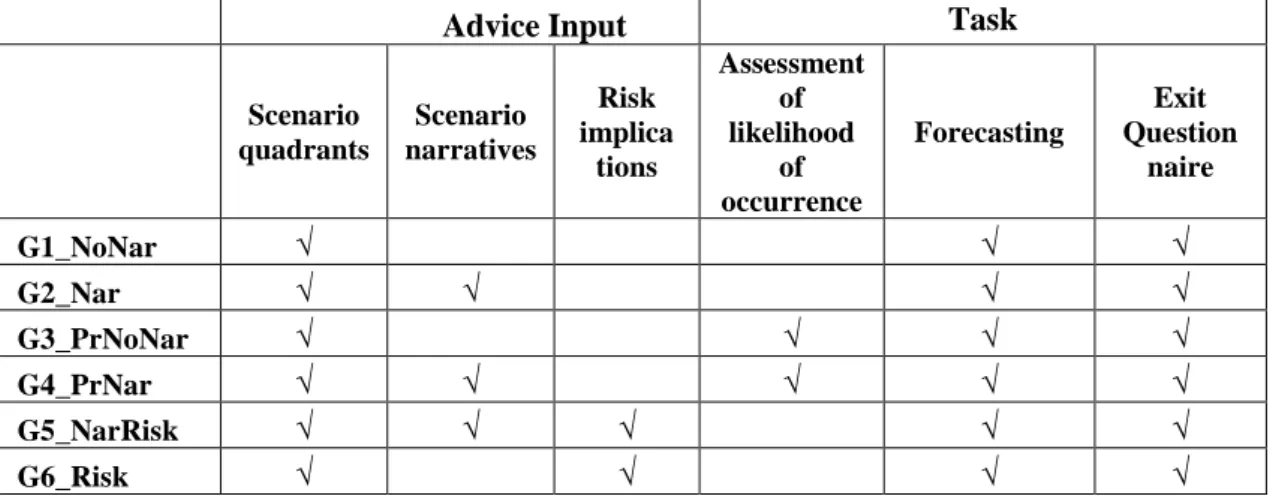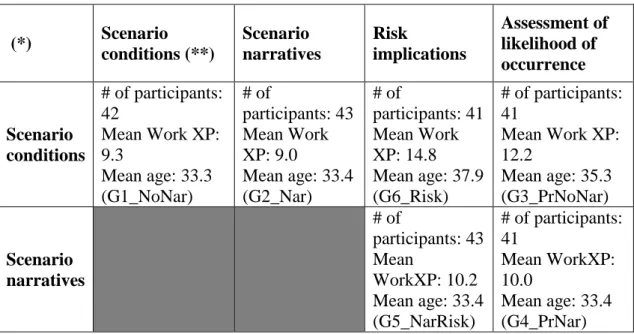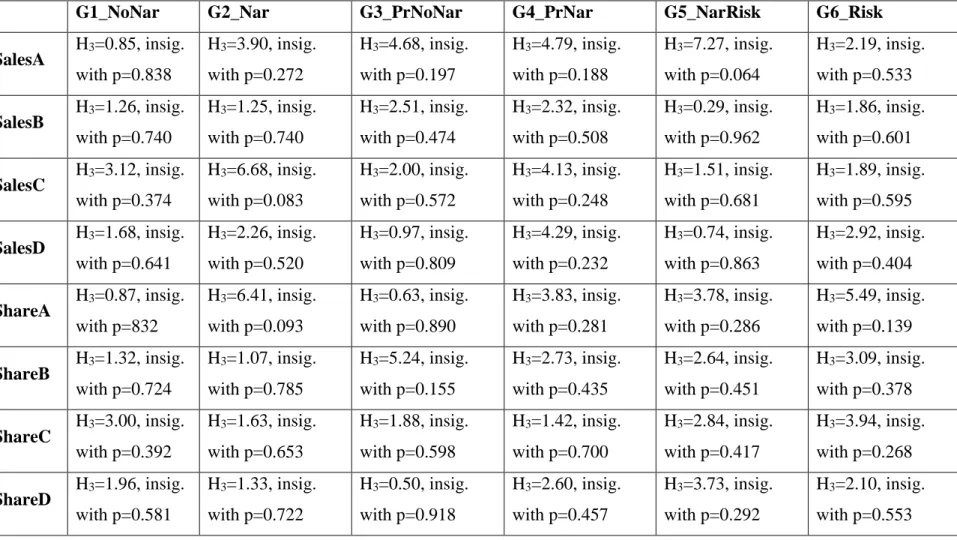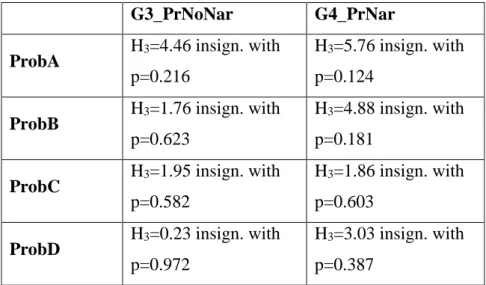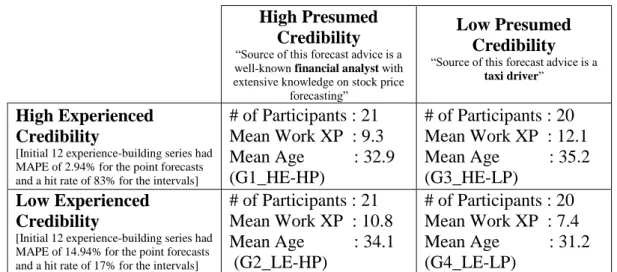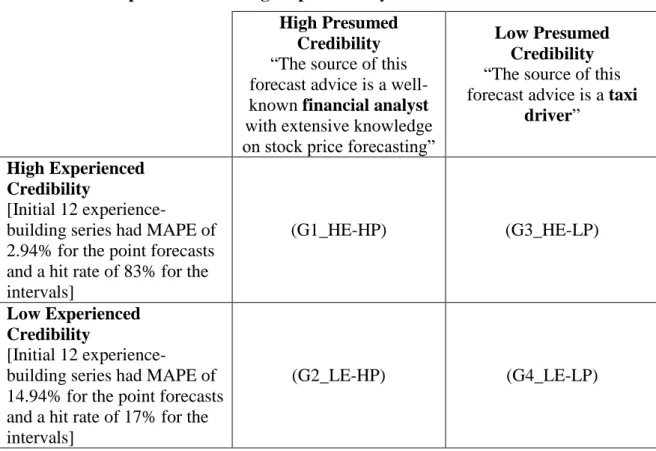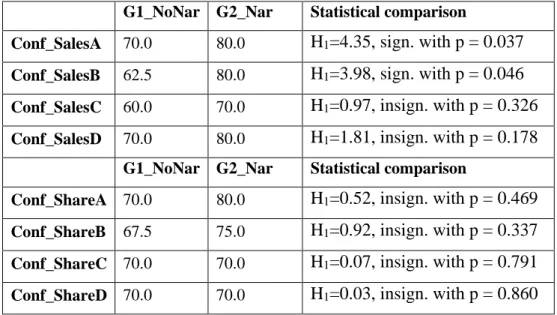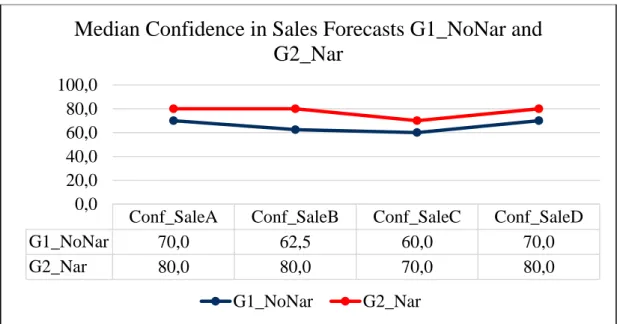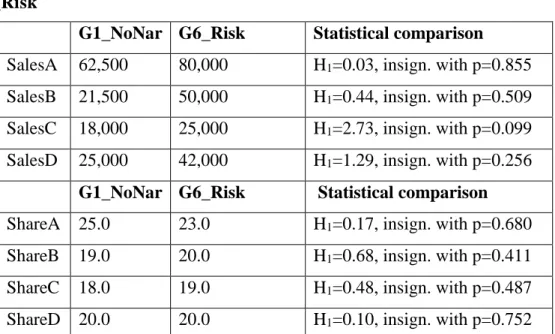JUDGMENTAL FORECASTS WITH SCENARIOS AND RISKS
A Ph.D. Dissertation
by ESRA ÖZ
The Department of Business Administration İhsan Doğramacı Bilkent University
Ankara
JUDGMENTAL FORECASTS WITH SCENARIOS AND RISKS
The Graduate School of Economics and Social Sciences of
İhsan Doğramacı Bilkent University
by ESRA ÖZ
In Partial Fulfillment of the Requirements for the Degree of DOCTOR OF PHILOSOPHY
in
THE DEPARTMENT OF BUSINESS ADMINISTRATION İHSAN DOĞRAMACI BILKENT UNIVERSITY
ANKARA
I certify that I have read this thesis and have found that it is fully adequate, in scope and in quality, as a thesis for the degree of Doctor of Philosophy in Business Administration.
………
Professor Dr. Dilek Önkal Supervisor
I certify that I have read this thesis and have found that it is fully adequate, in scope and in quality, as a thesis for the degree of Doctor of Philosophy in Business Administration.
………
Associate Professor Dr. Mustafa Sinan Gönül Examining Committee Member
I certify that I have read this thesis and have found that it is fully adequate, in scope and in quality, as a thesis for the degree of Doctor of Philosophy in Business Administration.
………
Assistant Professor Dr. Celile Itır Göğüş Examining Committee Member
I certify that I have read this thesis and have found that it is fully adequate, in scope and in quality, as a thesis for the degree of Doctor of Philosophy in Business Administration.
………
Associate Professor Dr. Ayşe Kocabıyıkoğlu Examining Committee Member
I certify that I have read this thesis and have found that it is fully adequate, in scope and in quality, as a thesis for the degree of Doctor of Philosophy in Business Administration.
………
Assistant Professor Dr.Yasin Nüfer Ateş Examining Committee Member
Approval of the Institute of Economics and Social Sciences ………
Professor Dr. Halime Demirkan Director
iii
ABSTRACT
JUDGMENTAL FORECASTS WITH SCENARIOS AND RISKS Öz, Esra
Ph.D., Department of Business Administration Supervisor: Prof. Dr. Dilek Önkal
June 2017
The purpose of this thesis is to investigate how scenarios and risks influence judgmental forecasts, forecaster’s confidence, and assessments of likelihood of occurrence. In its attempt to identify the impact of scenarios and risks as channels of forecast advice, this research reports the findings on the use of advice from six experimental groups with business practitioners as participants. Goal was to collect evidence and interpret the reasons and motivations behind judgmental forecasts from actual business life, as well as to identify the possible biases of forecasters after reviewing certain scenarios and risks. This thesis also presents analyses on the use of advice corresponding to the credibility attributes of advisors, i.e., “experienced credibility” and “presumed credibility”. Following a discussion of the results, future research directions are provided.
iv
ÖZET
SENARYO VE RİSK DESTEKLİ YARGISAL TAHMİNLER Öz, Esra
Doktora, İşletme Bölümü Tez Yöneticisi: Prof. Dr. Dilek Önkal
Haziran 2017
Bu çalışmada temel amaç, senaryo ve risklerin yargısal tahminlere, tahmin yapıcıların özgüvenine ve olasılık değerlendirmelerine etkilerini incelemektir. Senaryo ve risklerin tahmin tavsiyesi olarak etkisinin tespit edilmesi kapsamında, bu çalışma altı deney grubu ile çalışanlardan tavsiye kullanımı konusunda elde edilen bulguları sunmaktadır. Araştırma; gerçek iş dünyasından kanıtlar toplamak, yargısal tahminlemelerin ardında yatan nedenleri ve motivasyonları yorumlamak, tahmin yapıcıların muhtemel eğilimlerini tespit etmek amacını taşımaktadır. Bu tez ayrıca tavsiye kaynağına ait nitelikler olan “deneyimlenmiş güvenilirlik” ve “kabul edilmiş güvenilirlik”in belirtilmesi ile ortaya çıkan tavsiye kullanımına dair analizleri sunmaktadır. Araştırmalardan çıkan sonuçlar tartışılmış ve gelecekteki araştırmalar için yeni fikirlere yer verilmiştir.
Anahtar kelimeler: Güvenilirlik, Muhakeme, Olasılık Değerlendirmesi, Senaryolar, Tahmin Eğilimi
v
ACKNOWLEDGMENTS
This thesis could not have been completed without the help and support of many people. It gives me great pleasure to express my gratitude to those who believed in me during the process of this dissertation.
My supervisor, Dr. Dilek Önkal, played a significant role not only supervising this thesis work, but also inspiring me personally. Her wisdom will be reflected in any decision that I make throughout my life. I will remember all that I have learned from her academically and personally forever. I was also very fortunate to have Dr. Mustafa Sinan Gönül, Dr. Celile Itır Göğüş and Dr. Ayşe Kocabıyıkoğlu on my thesis committee. Their helpful comments and feedback helped improve the quality of this work significantly and provided guidance for a rigorous research.
I am indebted to the remarkable management, faculty and administrative staff at Bilkent University for providing a world class research environment and the opportunity to interact with a diverse group of researchers. I would also like to thank the TÜBİTAK BİDEB scholarship program for supporting me with graduate student funding on this journey.
vi
My dear husband, Emrah Öz, my greatest source of encouragement: I am thankful to you for making me feel loved and supported along the way. I thank God for everyday we are together sharing our lives.
I would like to express my gratitude to the members of the Sarıarslan and Öz families. This thesis has been possible thanks to your eternal patience, unconditional support and caring. Words cannot express my appreciation for you.
Finally, I would like to express my sincere gratitude to my research participants for giving me their precious time to respond to the forecasting tasks, to have conversations together and making this business research possible in the first place.
vii
TABLE OF CONTENTS
ABSTRACT ... iii
ÖZET ... iv
ACKNOWLEDGMENTS ... v
TABLE OF CONTENTS ... vii
LIST OF TABLES ... xi
LIST OF FIGURES... xiii
CHAPTER-1: INTRODUCTION ... 1
1.1. Contribution of the Dissertation ... 7
1.2. Structure of the Dissertation ... 12
CHAPTER-2: LITERATURE REVIEW ... 14
2.1. Introduction ... 14
2.2. Advice Taking ... 15
2.3. The Use of Advice and Type of Advice ... 17
2.4. Expert Knowledge Elicitation and Advice Credibility ... 20
viii
2.6. Scenarios as Forecast Advice ... 34
2.7. Unpacking the Scenario Content: State and Effect ... 37
2.8. Scenario Narratives and Resultant Risk Implications ... 38
2.9. Risk and Risk Perception ... 41
2.10. Subjective Probability Assessments: Likelihood of Occurrence ... 46
2.11. Assessment of Likelihood of Occurrence of Scenarios ... 48
2.12. Confidence ... 50
2.13. Optimistic and Pessimistic Scenarios, Positivity Bias, Wishful Thinking………...55
2.14. Common Heuristics and Biases in Decision Making ... 58
2.14.1. Representativeness Heuristic ... 58
2.14.2. Availability Heuristic ... 59
2.14.3. Simulation Bias ... 61
2.14.4. Affect Heuristics ... 62
CHAPTER-3: RESEARCH QUESTIONS ... 65
3.1. Research Questions of Study-1a ... 65
3.2. Research Questions of Study-1b ... 71
3.3. Research Questions of Study-2 ... 75
CHAPTER-4: EXPERIMENTAL DESIGN AND METHODOLOGY... 77
4.1. Experimental Design of Study-1 ... 77
4.2. Research Methodology of Study-1 ... 89
4.3. Experimental Design of Study-2 ... 104
4.4. Research Methodology of Study-2 ... 110
ix
5.1. Data Analysis and Findings of Study-1a ... 114
5.2. Data Analysis and Findings of Study-1b ... 147
5.3. Coding in Study-1 ... 157
5.4. Additional Insight on Study-1: Variance of Sales Forecasts ... 159
5.5. Data Analysis and Findings of Study-2 ... 161
CHAPTER-6: DISCUSSION ... 172
6.1. Influence of Scenarios and Risks on Judgmental Forecasts and Confidence……….173
6.2. Patterns within the Intuitive Logics Scenario Quadrants ... 178
6.3. Comparisons of Confidence ... 181
6.4. Incorporating Likelihood of Occurrence Assessments before the Use of Advice for Forecasting and Analyses on the Likelihood of Occurrence in ILS framework ... 183
6.5. Other Biases Identified During Forecasting Tasks ... 189
6.6. Credibility of Advice and Willingness to Use Advice ... 192
6.7. Limitations ... 194
6.8. Future Research ... 196
CHAPTER-7: CONCLUSION ... 198
BIBLIOGRAPHY ... 201
APPENDICE ... 222
Appendix-1: Wearable Electronic Devices and Historical Data ... 222
Appendix-2: Full List of Driving Forces ... 223
Appendix-3: Choosing the Two Primary Driving Forces ... 224
x
Appendix-5: Skewness of Each Data Set ... 239
Appendix-6: Sample Views from Typeforms ... 240
Appendix-7: Sample Information to Experienced Credibility ... 243
xi
LIST OF TABLES
Table 1. Description of the study groups in Study-1a and Study-1b ... 89
Table 2. Statistical power analysis results of Study-1... 94
Table 3. Descriptive statistics for test groups in Study-1a and Study-1b ... 97
Table 4. Order effect statistical results of sales and market share forecasts ... 100
Table 5. Order effect statistical results of confidence ... 101
Table 6. Order effect statistical results of likelihood of occurrence assessments .... 102
Table 7. Descriptive statistics for test groups in Study-2... 107
Table 8. Summary of judgmental adjustment measures ... 108
Table 9. Description of the test groups in Study-2... 111
Table 10. Statistical power analysis results of Study-2... 112
Table 11. Median sales and market share forecasts in G1_NoNar and G2_Nar... 117
Table 12. Median confidence in sales forecasts in G1_NoNar and G2_Nar ... 118
Table 13. Forecasters’ median ratings for the usefulness of scenario based advice and risk based advice ... 121
Table 14. Median sales and market share forecasts in G1_NoNar and G6_Risk .... 123
Table 15. Confidence in sales and market share forecasts in G1_NoNar and G6_Risk ... 126
Table 16. Sales and market share forecasts in G2_Nar and G6_Risk ... 130
Table 17. Confidence in sales and market share forecasts in G2_Nar and G6_Risk132 Table 18. Comparison of confidence in sales forecasts for level changes ... 135
Table 19. Wilcoxon signed rank test results for sales forecasts in G1_NoNar, G2_Nar, G5_NarRisk and G6_Risk ... 140
xii
Table 20. Pairwise comparisons of confidence in sales forecasts in G1_NoNar,
G2_Nar, G5_NarRisk and G6_Risk ... 145
Table 21. Pairwise comparisons of confidence of market share forecasts in G1_NoNar, G2_Nar, G5_NarRisk and G6_Risk ... 146
Table 22. Confidence in sales and market share forecasts in G3_PrNoNar and G4_PrNar ... 148
Table 23. Median probabilities in G3_PrNoNar and G4_PrNar ... 150
Table 24. Comparison of pairwise median probabilities within G3_PrNoNar ... 151
Table 25. Comparison of pairwise median probabilities within G4_PrNar ... 151
Table 26. Confidence in sales and market share forecasts in G2_Nar and G4_PrNar ... 155
Table 27. Coding summary ... 157
Table 28. Variance in sales forecasts in each test group ... 160
Table 29. Judgmental adjustments on initial professionals’ forecasts ... 162
Table 30. Mean advice utilization scores for ordinary cases in forecasts ... 166
xiii
LIST OF FIGURES
Figure 1. Schwartz’s eight step scenario planning process ... 38
Figure 2. Intuitive Logics Scenario framework ... 80
Figure 3. Intutive Logics Scenario schema revisited ... 85
Figure 4. Power analysis graph for two independent groups, non parametric ... 95
Figure 5. Power analysis graph for two dependent groups (matched pairs), Wilcoxon non-parametric ... 95
Figure 6. Power analysis graph for ANOVA, Repeated measures, within-between interaction ... 113
Figure 7. Boxplot of sales forecasts in G1_NoNar and G2_Nar... 116
Figure 8. Median sales forecasts in G1_NoNar and G2_Nar... 116
Figure 9. Median market share forecasts in G1_NoNar and G2_Nar ... 117
Figure 10. Median confidence in sales forecasts in G1_NoNar and G2_Nar ... 119
Figure 11. Median confidence in market share forecasts in G1_NoNar and G2_Nar ... 120
Figure 12. Boxplot of sales forecasts in G1_NoNar and G6_Risk ... 122
Figure 13. Median sales forecasts in G1_NoNar and G6_Risk ... 123
Figure 14. Median market share forecasts in G1_NoNar and G6_Risk ... 124
Figure 15. Median confidence in sales forecasts in G1_NoNar and G6_Risk... 125
xiv
Figure 17. Median confidence in market share forecasts in G1_NoNar and G6_Risk
... 126
Figure 18. Boxplot of sales forecasts in G2_Nar and G6_Risk ... 128
Figure 19. Median sales forecasts in G2_Nar and G6_Risk ... 128
Figure 20. Median market share forecasts in G2_Nar and G6_Risk ... 129
Figure 21 Median confidence in sales forecasts in G2_Nar and G6_Risk ... 131
Figure 22. Median confidence in market share forecasts in G2_Nar and G6_Risk . 131 Figure 23. Boxplot of confidence in sales forecasts in G1_NoNar, G2_Nar, G5_NarRisk and G6_Risk ... 133
Figure 24. Median confidence in sales forecasts in G1_NoNar, G2_Nar, G5_NarRisk and G6_Risk ... 133
Figure 25. Boxplot of sales forecasts in G1_NoNar, G2_Nar, G5_NarRisk and G6_Risk ... 137
Figure 26. Median sales forecasts in G1_NoNar, G2_Nar, G5_NarRisk and G6_Risk ... 137
Figure 27. Boxplot of confidence in sales forecasts in G1_NoNar, G2_Nar, G5_NarRisk and G6_Risk ... 142
Figure 28. Median confidence in sales forecasts in G1_NoNar, G2_Nar, G5_NarRisk and G6_Risk ... 143
Figure 29. Median confidence of market share forecasts in G1_NoNar, G2_Nar, G5_NarRisk and G6_Risk ... 144
Figure 30. Boxplot of confidence of market share forecasts in G1_NoNar, G2_Nar, G5_NarRisk and G6_Risk ... 144
Figure 31. Median confidence in sales forecasts in G3_PrNoNar and G4_PrNar ... 149
Figure 32. Median confidence in market share forecasts in G3_PrNoNar and G4_PrNar ... 149
Figure 33. Median confidence in sales forecasts in G2_Nar and G4_PrNar ... 155
Figure 34. Median confidence in market share forecasts in G2_Nar and G4_PrNar ... 156
Figure 35. Median ratings for individuals’ willingness to use forecast advice under each source credibility condition ... 169
xv
Figure 36. Forecasters' confidence comparisons between G1_NoNar, G2_Nar,
1
CHAPTER-1: INTRODUCTION
Research on advice giving and advice taking offers insight into how people learn from others and how open they are to receiving others’ wisdom. Forecasting decisions, in particular, are often made by individuals after consulting with, and being influenced by others (Bonaccio & Dalal, 2006). Considering other perspectives takes attention and energy because it requires individuals to move from the comfortable familiarity of how they are used to seeing things (Epley, Keysar, Van Boven, & Gilovich, 2004) to the unfamiliar position of an outside point of view. Research findings on the use of advice are likely to guide advisors on “becoming more influential” and raise advisees’ awareness on “their vulnerabilities” during the use of advice. To be specific, this dissertation examines how forecasts and forecasters’ confidence are affected by forecast advice in the form of scenarios and risks, how exposure to various scenarios influences individuals while making assessments of likelihood of occurrence and how forecasts are impacted by the use of
2
advice from sources differing in presumed and experienced credibility. Specifically, it aims to explore whether scenario content has any influence over forecasts and confidence, what kind of tendencies may arise based on various scenario contents in an intuitive logics scenario framework with a focus on individuals’ biases, and whether two levels (i.e., high and low) of two credibility attributes (i.e., presumed and experienced credibility) pertaining to the advisor influence forecasters to use that advice.
This chapter provides an overview of the research and articulates the questions that inspired and guided the entire research process. I set this inquiry in the context of seven distinct bodies of literature: scenarios; risk perception; assessment of the likelihood of occurrence; heuristics and biases; forecasting, expert advice and credibility. I then describe the dissertation’s method and data analysis, concluding with a discussion of the contribution this research intends to make to the field.
A restrictive definition describes advice as a specific recommendation concerning what the decision maker should do. (e.g. Harvey & Fischer, 1997). Several researchers have begun calling this definition into question. Dalal and Bonaccio (2010) categorized advice under four types. The general definition of advice imposes a recommendation in favor of a particular course of action and it is “Recommend For” whereas a recommendation against a particular course of action is categorized under “Recommend Against”. Information advice concerning one or more alternatives without explicit endorsement of any alternative is “Information” type advice. If the aforementioned type of advice is accompanied by another form of interpersonal assistance, such as socio-emotional support, it can be studied under “Social Support” (Dalal & Bonaccio, 2010). Each advice type may generate different
3
reactions in decision makers. Research findings on the use of advice should recognize this. In their work, Dalal and Bonaccio (2010) present findings which show that the motive to maintain autonomy, (i.e. Information type advice) is likely to relate to the acceptance of advice. In this respect, Information type advice deserves a detailed investigation. Study-1 in this dissertation focuses on scenarios as they are deemed as good representatives of Information type advice.
We do not yet fully understand decision makers’ reactions while dealing with scenarios. Once we know more, it will be possible to improve on existing scenario practices and derive greater benefit from scenario methodology. Study-1 of this dissertation is split into two parts: Study-1a and Study-1b. Study-1a compares scenarios with different contents and evaluates whether the scenario contents change forecasters’ predictions and confidence. Study-1b focuses on incorporating the treatment of the assessment of likelihood occurrence to scenarios. In doing so, this work would like to identify any vulnerabilities and pitfalls decision makers may face in their attempt to benefit from the intuitive logics method, which has become the default scenario technique since Schwartz (1991) published his best-seller, The Art of the Long View. The method selects two primary dimensions of uncertainty, creates a 2X2 matrix and elaborates. The four quadrants represent the four alternative combinations of these two uncertainties, each of which contains a kernel or logic of a plausible future. Each kernel is then elaborated into a narrative, and the implications for the focal issue or decision are discussed (Bishop, Hines & Collins, 2007).
How can scenario methodology be improved and where might it still fall short due to some decision making biases? This dissertation attempts to identify any
4
biases that occur while using scenarios as channels of forecast advice. It focuses on some of the methodological and practical concerns of scenarios for forecasting. It discusses possible improvements to scenario content, debiasing recommendations with special consideration of their useful implications as a business planning tool.
Debiasing refers to the procedure of reducing or eliminating the biases in the decision making strategies of the decision maker. Fischhoff (1982) proposed four steps that decision making teachers or trainers can follow to encourage their students to make wiser judgments: (1) offer warnings about the possibility of bias, (2) describe the direction of the bias, (3) provide a dose of feedback, and (4) offer an extended program of training with feedback, coaching, and anything else it takes to improve judgment. This work attempts to identify any vulnerabilities and biases decision makers may be influenced by as they are using scenarios. It should be noted that one can offer warnings about the possibility of bias only after the bias is described. Fischhoff (1982) also argues that debiasing is an extremely difficult process that must be closely monitored and guided by a psychological framework for change. This work may pave the way for developing debiasing recommendations for forecast advice takers after examining their perceptions of varying scenario contents.
With the proverbial clock ticking faster than ever in business, executive boards are always seeking a deeper and better understanding of the future. Companies update their strategy reports periodically in preparation for the future. These strategy reports cover supporting information such as forecast sales figures and market share for a medium term horizon. The forecasts become crucial reference points for action plans and investment plans. Forecasts initiated today are not limited
5
to the company’s internal operations planning; they are also related to the perception of a company’s present value. The perception of a company’s present value is driven to a great extent by the future sales volume and market share, both of which are key determinants of a company’s stock price, and are thus important indicators for the investors.
Since 1960, the scenario approach has been used intensively to integrate several possible futures into the planning process. Scenarios are not predictions or forecasts; rather, they seek to define uncertainty and make it explicit. Önkal, Sayım and Gönül (2013) studied the effectiveness of scenarios as channels of forecast advice. Their paper offered an exploratory attempt at using scenarios in forecast communication and advice taking processes by giving scenarios to forecasters as additional forecast information. The paper successfully illustrated the very first step in examining how scenarios could be used as channels of forecast advice. They explain that storytelling promises to facilitate a rich platform where scenarios can play an important role to improve forecast communication and predictive accuracy within organizations. While using scenarios as channels of forecast advice, having consistency checks to alleviate biases, enriching the content of scenarios, enhancing the credibility of scenarios, fostering trust via scenario-sharing would ensure forecasters derive maximum benefit from scenarios.
Peter Drucker has emphasized that long range planning does not deal with future decisions (1959). Rather it deals with the “futurity” of present decisions. The scenario technique is a useful way of obtaining a clear image of future alternatives and events. Using various types of proven scenario methods, it is possible to see the
6
interactions between driving forces and uncertain events, which illustrate possible futures in a structured way, thereby enabling quantitative predictions to be made with deeper understanding. While the technique may not be able to offer final answers to strategic decisions, it certainly enhances a decision maker’s understanding and challenges conventional thinking (Wright, Bradfield & Cairns, 2013).
In many organizations, human judgment plays the primary role in forecasting (e.g. Klein & Linneman, 1984). Even when quantitative methods are used, results often require adjustment with expert judgments (Bunn & Wright, 1991). Understanding how these judgments are formed is essential. Fischhoff and MacGregor emphasize that a forecast must not only predict the future, but also give some indication of how much confidence to place in that prediction (Fischhoff & MacGregor, 1982). In this respect, it is important to know how forecasters’ confidence gets affected by either content or treatment of scenario planning in an organization. This study is an initial attempt to address this gap in the literature.
The quality and evaluation of scenario techniques have been discussed in great length in the literature. However, judgmental decision making on enriched scenario content has not. To date, the influence of different contents; i.e., scenario narratives and risk implications on forecasts and confidence, has not been investigated. Scenario development is not an everyday task; the process requires long hours of rigorous work and is usually exclusive to a small group of senior decision makers. An investigation on different scenario contents appears as a challenging and time consuming mission, from its relevant scenario development stage onwards. In addition, such an investigation calls for the involvement of a large sample
7
comprising a broad and diverse group of respondents. The difficulty of scenario development in compliance with research methodologies inevitably makes such a study a challenge, as well.
Study-2 of this dissertation takes a close look at expert knowledge elicitation through labels of credibility. As Swol and Sniezek (2005) listed five factors that affect the acceptance of advice; namely advisor confidence, advisor accuracy, the advisee’s trust in the advisor, the advisee’s prior relationship with the advisor, and the advisee’s power to pay for the advisor’s recommendations, this study examines the credibility issue with an emphasis on its different types. In this work, the credibility level of the advice source can be viewed from the perspectives of “presumption” which is based on the title, status of the advice source and “experience” which is based on the track record of the advice source. Presumed credibility represents social acknowledgment and experienced credibility represents the observed accuracy in the advisor’s forecasts. The goal of Study-2 is to examine how forecasters adjust their forecasts after reviewing forecasts from sources labeled by the level of presumed credibility or experienced credibility.
1.1. Contribution of the Dissertation
In terms of the first contribution; the relative influence of scenario content on judgmental forecasts and forecasters’ confidence will be investigated in this thesis. Past research is sorely lacking in this area. The empirical results will present contributions towards scenario methodology.
At this point, it will be useful to provide more information on the vocabulary used in this work. Here, the term “intuitive logics scenario framework” (hereafter
8
“ILS framework”) denotes a 2X2 matrix where conditions are presented around two driving forces. The ILS framework displays four quadrants which supply alternatives of the future in the form of narratives or risk implications. “Scenario narratives” denote stories expressed in one of the four “quadrants” of this ILS framework. “Risk implications” denote negative outcomes caused by exposure to a specific scenario condition.
As this work draws attention to scenario content, it has chosen to contextualize the research on sales volume and market share forecasts. These variables can be listed under “gains” rather than “costs”. Although business scenarios have proven themselves as irresistible to organizations since the 1960s, business literature has not yet clarified to what extent judgmental forecasts change when risks are incorporated into the ILS framework. Perceived differences based on a change in the “framed” wording of alternatives can dramatically affect how people make decisions (Kahneman & Tversky, 1979). While a future condition can bring risks and opportunities at the same time, an expert can provide that condition in frames; i.e., representing only the resultant “risks”. Reviewing only risks in each scenario quadrant as forecast advice has the potential to impact the forecasters’ confidence. This study is the first attempt to address this gap in the literature.
In extant literature, there is a lack of quantitative findings on how forecasts change with positive-state and negative-state scenarios. Going one step further; how forecasters’ confidence is shaped while using scenario narrative based advice or risk based advice in an intuitive logics framework (i.e., which serves as an effective tool considering the limited time and judgmental power of humans) has not been
9
examined. Comparing forecasters’ confidence “with scenario narratives and/or risks” to “without any scenario narratives/risks” stands as a promising investigative opportunity.
In terms of the second contribution, this work uses intuitive logic scenarios, which provides four mutually exclusive and collectively exhaustive scenarios for describing the future. Scholars have not focused on this distinctive characteristic so far. Extant literature has only studied best and worst case scenarios without much attention to moderate scenarios. Researchers have discussed general findings on decision makers’ attitudes after reviewing scenarios. This work will present case-specific findings pertaining to four mutually exclusive and collectively exhaustive scenarios. This is going to be a theoretical contribution to the general findings on decision making with scenarios and biases as the study collects data through participants.
It should be noted that both academics and practitioners doubt whether using any scenario content has any significant impact on the assessment of likelihood of occurrence. As a third contribution, this work may find out whether the incorporation of an additional treatment during scenario analysis, i.e., the assessment of likelihood of occurrence, influences forecasters’ confidence while using scenarios offered as forecast advice.
If reference historic frequencies are not obvious, possibly because the event to be forecast is truly unique, the only way to assess the likelihood of the event is to use a subjective probability produced by judgmental techniques. Perceived likelihood of occurrence for each quadrant may change if the quadrants present narratives.
10
Within the scope of the fourth contribution, decision making biases that arise during assessment of likelihood of occurrence could be identified.
As the fifth contribution, this work will try to interpret how forecasts, forecasters’ confidence and likelihood of occurrence assessments are shaped among the four quadrants of the intuitive logic scenarios. One of the four quadrants may surpass the others as a reference point for forecasters during the use of scenario advice. This is going to be a theoretical contribution differentiating the four separate quadrants by negativity amount (i.e., intuitive logic scenarios involve four quadrants which represent either zero, one or two negative directions).
Study-1 of this dissertation explores the ILS framework which is offered to forecasters as Information type advice while they work on their predictions for the year 2021. The context of the Study-1 is based on the wearable technology market. This market is new and rapidly growing, with only several years of history. Many people wonder how dominant wearable technology products will be in 2021. While many market researchers have been brainstorming the possible futures in different forms, this work formulates the future on 2X2 scenarios in compliance with experimental research methodologies and presents sales volume and market share forecasts as variables. For the study, first the participants are informed about the company’s sales and market share for the past two years as the market is only two years old and older data is not available. In this case, computerized forecasting models (i.e., time series models) are obviously inapplicable. Decision makers require judgmental forecasting methods. With different types of information treatments, they make forecasts for the year 2021 and indicate their confidence. Going back to the
11
substantial purpose of this set of studies, if we can understand the judgment processes with scenarios, we might be able to discuss any improvements as the next step.
Forecasters may exploit many types of inputs and tools during their studies. This could be “Information” type advice such as a set of future scenarios supplied in Study-1 or this could be unidirectional “Recommend For” type advice such as the future value of a certain stock supplied in Study-2 of this dissertation. Advice can be described with its source possessing high or low experienced credibility, high or low presumed credibility.
Study-2 of this dissertation explores an important issue on the advisor credibility: What happens when the two attributes of experts (i.e., track record of accuracy (experienced credibility) and their apparent status (presumed credibility) yield conflicting indications of credibility? As the sixth contribution, this work compares forecasters’ adjustments after reviewing presumed and experienced credibility sources and attempts to figure out whether one of these attributes is more influential on forecasters to make an adjustment on their forecasts and to use that advice.
Study-2 of the dissertation uses a different forecasting task in its attempt to analyze users’ reactions to the credibility attribute. Forecasters review 12 time series plots of weekly closing stock prices for a 30 week period and generate a point forecast and an interval forecast for the 31st week. Advisors are presented to the forecast advice takers with either high or low presumed / experienced credibility attributes. In the second stage, the forecasters review forecasts generated by these
12
advisors and they make forecasts after having access to the advisor’s “Recommend
For” type advice. This work attempts to analyze the strategies of forecasters in
taking advice under the credibility framework. The findings will shed light on forecasters’ willingness to use forecast advice when they have information regarding the credibility attribute of the source of the advice.
This dissertation aims to make a sound contribution to the business scenario and expert credibility literature with a data set collected from business professionals. Many researchers in management have drawn attention to the increasing gap between academia and business, despite being two sides of the same coin (Petropoulos & Kourentzes, 2016). After checking a wide range of relevant databases and journals, it appears that, so far, the literature has not hosted a study where judgmental data derived of scenarios is collected from practitioners. This work is an attempt at producing and disseminating findings directly applicable to practice by business people.
1.2. Structure of the Dissertation
This dissertation mainly has seven chapters. This chapter presents an introductory discussion of the purpose of the research and the structure of the dissertation. In Chapter-2, literature review on scenarios, advice taking, subjective probability assessments, potential biases influential on both forecasting and likelihood assessments is provided with their implications for this dissertation. Following this, Chapter-3 presents the research questions being addressed in this dissertation. Chapter-4 explains the experimental design and the methodology. Chapter-5 elaborates on the data analyses and findings of this research. Chapter-6
13
integrates the findings into a discussion framework. Each finding focuses on the grounding literature of the topic at hand and how these new findings matched, challenged or contributed to them. It also presents the limitations in this work and addresses new directions for future research. Finally in Chapter-7, the dissertation is concluded by addressing some recommendations that could improve on the use of advice based on general discussions.
14
CHAPTER-2: LITERATURE REVIEW
If one understands the judgment process, there is a good chance of improving it. If one can improve the judgment process, one should be able to improve the resulting judgments and decisions they imply (Brockhaus, 1975:127).
2.1. Introduction
This chapter firstly introduces the research topic within the context of scenarios and forecasting research to address Study-1. It presents how scenario studies have positioned themselves as complementary tools to forecasting and enhancing knowledge on what the future may unfold. Any attempt to clarify the unclear future helps forecasters. Scenario narratives and risk implications have come to play a role in this context.
Next, this chapter discusses heuristics and biases, confidence and risk perception in relation to intuitive logics methodology. These include the literature around scenario analysis, heuristics, risk assessment and likelihood of occurrence
15
assessments. It also mentions how literature on forecasting has developed in relation to these issues. Finally, it discussess the history and theory of scenario planning, reviewing the literature on how it became so useful with its strengths and limitations. This part ends with a discussion of how the research in this dissertation fits within the overall landscape of this literature.
The chapter secondly introduces the research topic on the expert knowledge elicitation models and credibility of the advice source. Information is given on the credibility attribute of forecast advice source, in particular on two attributes of credibility (i.e., presumed and experienced credibility) to address Study-2. The research inquires how forecasters’ willingness to use forecast advice changes based on the advice type or attributes of the advisor. The next heading continues by elaborating more on the main theme: Advice taking, the use of advice and the type of advice.
2.2. Advice Taking
Many companies typically tend to focus on their immediate business environment. They spend most of their energy and resources keeping up with developments related to their familiar set of products, customers, competitors, technologies and stakeholders. Such focus may result in missed key signals from the peripheral environment. For many real-world decisions ranging from the smallest to the crucially important, organizations need to combine information from multiple sources before taking action (Wallsten, Budescu, Erev & Diederich, 1997). Advice could be one of these sources. In fact, greater uncertainty about a task is supposed to
16
lead forecasters to consider an expert advisor’s advice (Swol & Sniezek, 2005); whether a scenario narrative or a risk implication.
In terms of differential information explanation, decision makers discount advice because they have limited access to the advisor’s internal thought processes and the rationale behind their own opinions while having privileged access to their own reasons (Yaniv, 2004; Yaniv & Kleinberger, 2000). In other words, when any forecast is provided to a manager, the assumptions behind this forecast is generally not known by the manager. Or potentially, the assumptions may not reflect the unexpected factors valid in business (Önkal et al., 2013). A decision maker’s initial estimate or choice serves as an “anchor” that s/he subsequently adjusts in response to received advice; such an adjustment is typically insufficient and this results in egocentric discounting of advice (Harvey & Fischer, 1997; Lim & O’Connor, 1995). This is also called asymmetric weighting, due to the asymmetry in access to the underlying justifications for the proposed opinion (Yaniv, 2004). All of these findings prove that it is in fact not so easy for a decision maker to shift away from his opinions. Decision makers are more likely to feel more confident with their own opinions. However, Grinyer (2000) asserts that an external facilitator is more likely to be accepted as an objective party. A scenario advisor can remain impartial throughout the proceedings and is therefore a suitable party positioned to challenge the usual and established views held by many decision makers. Acting as a facilitator who encourages broader and deeper thought on the business environment outside the company, a scenario advisor can contribute to an organization significantly. Then what happens if an advisor provides a structured rationale with narratives (i.e., ILS) when the forecaster on his own does not have such narratives? This work is curious
17
to know which, scenario narratives or risk implications, are more influential as advice on forecasters’ confidence. This may provide a cue about decision makers’ reference point as well. This work’s goal is to investigate the potential of ILS with scenario narratives and risk implications to influence forecasts and forecasters’ confidence. In addition, this work wants to examine what happens if an additional treatment during scenario studies (i.e., assessment of the likelihood of occurrence) contributes to the forecasters’ confidence.
Van Swol and Sniezek (2005) emphasized five factors that affect the acceptance of advice: advisor confidence, advisor accuracy, the advisee’s trust in the advisor, the advisee’s prior relationship with the advisor, and the advisee’s power to pay for the advisor’s recommendations. The forthcoming titles elaborate more on the credibility of the advice source.
2.3. The Use of Advice and Type of Advice
The decision making literature on advice giving and taking has typically defined advice as a specific recommendation concerning what the decision maker should do (e.g., Harvey & Fischer, 1997). However, several researchers have begun calling this restrictive definition into question. Dalal and Bonaccio (2010) classified advice types in four groups based on their characteristics. The first type of advice is a recommendation in favor of a particular course of action (‘‘Recommend For”). This represents only one facet of a broader advice construct. One additional type of advice is a recommendation against a particular course of action (‘‘Recommend Against”). The third type of advice is the provision of information concerning one or more alternatives, without explicit endorsement of any alternative (“Information”).
18
Information is typically presented in a factual or non-normative framework. In contrast to Information, Recommend For (and presumably Recommend Against as well) “has a normative, almost moral dimension describing certain courses of action” (Pilnick, 1999: 614). The fourth type of advice may supply support directed towards helping the decision maker decide how to decide (“Decision Support”). In other words, the advice involves the process by which the decision is made (Gibbons, 2003). All these types of advice may in many cases be accompanied by another form of interpersonal assistance (“Social Support”). The provision of socio-emotional support acknowledging the importance and difficulty of the decision to be made is not a type of advice, but it is a form of the broader construct of interpersonal assistance. Upon this classification, Dalal and Bonaccio worked on what kind of advice decision makers prefer.
Several motives are influential on decision-makers’ receptivity to assistance from an advisor. The literature mainly contains research on motives for maximizing decision accuracy. Despite the common expectation, Dalal and Bonaccio (2010) argue that decision makers’ motivation to accept some advice usually does not relate to its accuracy; it is more about getting other factors satisfied such as the advisee’s autonomy. They state that the motive to maintain autonomy is dominantly influential on the acceptance of advice. Many researchers (Caplan & Samter, 1999; Goldsmith, 2000; Goldsmith & Fitch, 1997) showed that people react less positively to interpersonal communications that violate their autonomy. One directional advice leads to a restriction of freedom. Dalal and Bonaccio (2010) claim that some types of advice maintain decision-makers’ autonomy more than others. In particular, greater
19
autonomy is preserved via “Information advice”, as they do not explicitly prescribe an alternative (Pilnick, 1999; Dalal & Bonaccio, 2010).
Dalal and Bonaccio’s (2010) findings suggest that recommendations in favor of some alternatives are important, but they cannot be the primary preferred type of advice. Decision makers place great importance on information about alternatives, and in many contexts information proves to be the most important type of advice since decision makers look for “autonomy”. Their research results suggest that advisors should provide decision-makers with different combinations of assistance in different situations, but also that information about alternatives should typically be among the types of assistance they provide. Dalal and Bonaccio (2010) warn advisors to remember to provide information along with their recommendations. Besides, they point to the gap in literature: decision making literature has not systematically studied the provision of information by advisors, and thus different contexts should be tested.
In the Study-1 of this dissertation, scenarios which depict the year 2021 were provided to professionals as “Information” type of advice. In Study-2, advice source credibility tests were held with professionals where professionals received
Recommend For advice and they were asked to make forecasts after reviewing this
type of advice. In this work, they received only a recommended future value of a certain stock to forecasters. Forecasters performed their tasks after reviewing each type of forecast advice in each study. Finally, they rated their willingness to use that piece of forecast advice. This work aims to figure out forecasters’ willingness to use
20
by comparing advisees’ judgmental adjustments and advice utilization and by means of Information advice comprising intuitive logics scenarios.
2.4. Expert Knowledge Elicitation and Advice Credibility
People generally decide to trust others when they encounter situations involving uncertainty (Dasgupta, 1988; Kollock, 1994; Sniezek & Van Swol, 2001), which is an antecedent to the decision to trust another (Mayer, Davis & Schoorman, 1995). If one is certain about a situation, there is no need for trust and making oneself vulnerable to others. The motivation for trusting another person is the possibility of finding a way to reduce that uncertainty (Lewis & Weigert, 1985; Sniezek & Van Swol, 2001).
In expert knowledge elicitation (EKE), the perceived credibility of an expert is likely to affect the weight attached to their advice. Swol and Sniezek (2005) listed five factors that may affect the acceptance of advice: advisor confidence, advisor accuracy, the advisee’s trust in the advisor, the advisee’s prior relationship with the advisor, and the advisee’s power to pay for the advisor’s recommendations. In this work, the two attributes of experts are in focus:
The track record of accuracy, which is categorized under “experienced credibility”
Apparent status, which is categorized under “presumed credibility”
The literature presents five possible models predicting the influence of expert advice. Seer sucker theory suggests that people are motivated to pay large sums of money when forecasts are elicited from experts even when their forecasting accuracy
21
is poor (Armstrong, 1980). Armstrong’s (1980) “seer sucker” theory suggests a “presumption-only” model. In this model, people are influenced by the advice of those whom they presume to have the status of expert, regardless of their track record. Frequently, feedback on advisor accuracy is not available. Stereotypes and assumptions about the source of advice (i.e., assuming that a financial advisor would better understand and analyze stock prices compared an artificial advisor.)
This study would like to investigate the extent to which two attributes of experts, their track record of accuracy and their apparent status, influence forecasters to adjust their forecasts and encourage them to purchase that advice. What happens when the two attributes of experts (i.e., track record of accuracy (experienced credibility) and their apparent status (presumed credibility)) yield conflicting indications of credibility? This work would like to check whether an advisor could be more influential when associated with presumed credibility rather than experienced credibility. The dominance of presumption may arise as advice takers are not usually motivated to examine the track record of their advisors. This activity takes processing time, and advisors may opt to avoid this effort.
At the other extreme is the “experience-only” model. In this model, presumed credibility has no influence on advisees when experience of the advice is available. Some researchers such as Brown, Venkatesh, Kuruzovich and Massey (2008) presented results supporting this model. They showed that expectations do not have any influence on users’ satisfaction with the ease-of-use of information systems. Satisfaction only depended upon experience with the system. Similarly, Irving and Meyer (1994) proved that experiences determined levels of job satisfaction rather
22
than expectations. Brown et al. (2008) inform that the dominance of experience may be due to the recency effect because experience always follows expectations. In forecasting, the latest experience may appear particularly influential. A good reputation can be easily erased after only few inaccurate forecasts (Yaniv & Kleinberger, 2000).
Literature presents evidence that satisfaction with advice will depend upon whether the experience confirms the presumption or disconfirms it. Anderson (1973) examined the discrepancies between expectations and experiences in relation to satisfaction with products. Bhattacherjee (2001) held a similar study in the context of information systems. Both studies revealed similar findings. Bhattacherjee (2001) states that when experience is consistent with expectations, user satisfaction with an information system increases. This is true in the case of low expectations as well, although in these circumstances satisfaction levels are less than where high expectations are confirmed (Venkatesh & Goyal, 2010). Brown et al. (2008) suggest two possible models of how satisfaction is fostered when such discrepancies arise. In the “disconfirmation model” better-than-expected experiences lead to a positive influence on satisfaction, due to a “positive surprise” effect. However, worse-than-expected experiences lead to reduced satisfaction because there is a “disappointment effect”. This model is in line with the “met expectations hypothesis”. Porter and Steers (1973) show that satisfaction depends on the difference between experiences and expectations. In this model, high experienced credibility will always have more influence on the use of advice than low experienced credibility. The former will raise satisfaction if it is unexpected, while the latter will lower it.
23
The model also predicts that high presumed and high experienced credibility will be more influential on advisees than low presumed and low experienced credibility based on Venkatesh and Goyal (2010)’s findings. However, while a “positive surprise” may have a positive effect on variables such as job satisfaction, which are directly related to the happiness of an individual, the same may not prove to be true in case of forecast advice. A conflicting direction between presumption and experience may lead to psychological discomfort or cognitive dissonance (Festinger, 1957) irrespective of whether the experience was better or worse than expected. In this case, an “ideal point model” (Brown et al., 2008) may apply. This model assumes there is an ideal “point” of experience where differences between presumption and experience keep to a minimum. People do not like to be wrong, they avoid it in contrast to the “disconfirmation model”. Even a better-than-presumed experience will lead to reduced satisfaction because the discomfort of thwarted presumption exceeds the satisfaction of a positive surprise (Carlsmith & Aronson, 1963; Oliver, 1977, 1980; Woodside & Parrish, 1972). The greatest influence on forecasters is observed when both presumed and experienced credibility are high, as there would be a synergistic effect. Each form of credibility enhances the influence of the other. Cognitive dissonance is absent because advisees do not experience any psychological discomfort (Elliot & Devine, 1994; Szajna & Scamell, 1993). High presumed credibility attribute may partially mitigate the reduced satisfaction arising from the discrepancy, but a better experience than the presumption will not serve to reduce this discomfort. Thus, its reducing effect on satisfaction will be even greater. In a practical context, this reduction in satisfaction may result from annoyance because a person described as an “expert” has exhibited
24
poor performance. Although advisees paid attention to his/her high presumed credibility, this poor performance may have catastrophic effects. Such a conflicting situation might push the advisees towards an exaggerated emotion. This seems unlikely, but it is likely to arise where there is a large amount of dissatisfaction from the discrepant experience.
This work aims to see how forecasters treat forecast advice labelled by joint attributes; i.e., presumed and experienced credibility, within the scope of adjusting forecasts, within the scope of willingness to use advice.
2.5. Scenarios and Forecasting
Russo, Schoemaker and Russo (1989) describe scenarios as script-like narratives that paint the future in vivid detail, and that show what may unfold in one direction or another. Wack (1985), Hamel and Prahalad (1996), Van der Heijden (2000), Fahey and Randall (1998) and Ringland and Schwartz (1998) describe scenario planning as a powerful tool to develop organizational foresight and facilitate organizational adaptation by increased communication. Aligica (2005) remarks the epistemic nature of scenarios and the growth of knowledge with scenarios. Intuitive logics scenario development methodology facilitates equal consideration of multiple scenarios. On the other hand, this work questions what kind of systematic biases may still be at stake.
This work facilitates an ILS framework with equal consideration of four mutually exclusive and collectively exhaustive scenarios. As Hodgkinson and Starbuck (2008), Goodwin and Wright (2001) emphasize in their work, evaluating scenarios systematically helps build the attention paid to multiple scenarios. They
25
also highlight that using scenarios in judgmental decision making help mitigating imbalanced consideration for the future. Hodgkinson and Starbuck (2008) list “managing the effects of scenarios on uncertainty and (over)confidence” as one of the five major challenges that organizations may confront.
Forecasters might best use scenarios to stimulate the use of more information when planning forecasts or to make a forecast accepted. Schoemaker (1991, 1993) advocates using scenarios to depict the range of possibilities. Scenarios decompose complexity into distinct states and present several alternative models.
Schoemaker, believing that scenarios enable a better understanding of future uncertainties (1991) envisions their use as a complement to traditional forecasting methods. Schoemaker proposes that when uncertainty is high, relative to an individual's or organization's ability to predict, forecasters can use scenarios to stimulate more complete searches for information relevant to the forecast. Schoemaker (1991) points out that the value of scenarios is that they make managers more aware. We live in a highly uncertain world and it is not always easy to think about the uncertainties in structured ways. Schoemaker believes scenarios might be a remedy to reduce overconfidence bias, overcome availability bias, shifting the anchor or basis from which people view the future (1991). He suggests that developing scenarios can be used to enhance the quality of forecasts or their acceptance. This work aims to check these in concrete terms through ILS framework. As an improvement to the scenario technique, Schoemaker (1993) recommends putting verbs in the past tense in scenarios. He provides the justification
26
as well past tense implies certainty. This work followed this advice and prepared the scenario narratives in the past tense.
Bunn and Salo (1993) categorize scenarios based on their objectives. Scenarios can fall into three types: (a) strategic planning and decision analysis, (b) risk and sensitivity analysis and (c) organizational learning.
Varum and Melo (2010) put forward in their paper that there is a consensus in the literature on three benefits of using scenarios, improvement of the learning process, improvement of the decision making process, and identification of new issues and problems (Varum & Melo, 2010). Other than telling what lies in the future, scenarios emphasize how that future might evolve (Goodwin & Wright, 2010). In line with this; Wright, Bradfield and Cairns (2013) point out that scenario methods are designed to enhance understanding and challenge conventional thinking. In this direction, the ability to learn faster than your competitors may be the only sustainable competitive advantage (De Geus, 1988). Scenarios give managers a precious opportunity: the ability to re-perceive reality (Wack, 1985). This dissertation mainly encompasses “decision analysis scenarios”.
Extant literature appreciates the power of scenarios because scenarios have been employed as helpful tools to generate ideas in a systematic fashion and enable better perception and better engagement to brainstorm different versions of the future. People from the business world and academia accept that scenarios provide a setting rich enough to trigger thought and further judgments. Using scenarios in order to make forecasts makes a great deal of sense when the degree of uncertainty and complexity in the external environment is high, when organizational difficulties have
27
been encountered in the past, especially at times when the company has experienced troublesome outcomes (Önkal, Sayım & Gönül, 2013). The sales volume of a new technology product line is a good forecasting variable for an uncertain and complex environment i.e., replenishing the retail and online shelves with a new, more up-to-date design and attracting customers emerge as natural obligations for technology companies wishing to remain in the market.
Gregory, Cialdini and Carpenter (1982) already presented findings that users are more likely to assign higher likelihoods to events presented with scenarios in comparison to events presented without scenarios. This work aims to examine this in an intuitive logics scenario framework where the total likelihood of occurrence assessment cannot exceed 100% every time. That means that if the likelihood assessment of several conditions goes up, that of the remaining conditions has to go down. Although experiments have been conducted to compare forecasts with and without scenarios, no work in the literature mentions results obtained from an ILS context. For instance, Önkal et al. (2013) worked with best case and worst case scenarios. They compared forecasts made with and without scenarios for each of the forecast formats (i.e., point forecast, best case forecast, worst case forecast, and surprise probability) to explore the potential effects of providing scenarios as forecast advice. Meissner and Wulf (2013) showed that the use of scenarios reduces framing bias and improves self-reported decision quality. The effectiveness of the scenario technique, in that it increases decision quality in strategy processes and improves performance has been empirically proven (Meissner & Wulf, 2013; Phelps, Chan & Kapsalis, 2001). While the scenario technique appears as an effective decision support tool, Kuhn and Sniezek (1996) point out that more work is needed to
28
investigate scenarios with forecasting. This dissertation takes an active role to meet this need.
It bears mentioning that there is not one specific scenario method. Bishop, Hines & Collins (2007) as well as Börjeson et al. (2006) illustrate scenario types, techniques and underlying theories. A total of 23 techniques can be listed for developing scenarios (Bishop et al., 2007). One feature that these scenarios share is that they try to develop multiple scenarios for the future, usually between two and four (O’Brien, 2004). Based on Börjeson’s categorization (2016), the scenario model this dissertation aims to utilize can be categorized under predictive scenarios. Predictive scenarios are forecasts of the future and answer the question “what will happen”. The findings from this dissertation will apply to predictive scenarios as a limitation of generalizability.
Various scenario reviews highlight the popularity of intuitive logics scenarios. For example, in a review of 35 sets of scenarios, over 24 (68%) are noted as having been developed using intuitive logics scenarios (Natural England Commissioned Report NECR031, 2009). Van Asselt, Van’t Klooster, Van Notten and Smits (2010) emphasize that this type is widely referred to as the “standard” by practitioners and scholars. The driving forces are ranked to represent high uncertainty and greatest potential impact over the time horizon, and they are used to construct the scenarios (Schwartz, 1991). The two primary high impact, high uncertainty and independent factors are combined to create a 2X2 scenario matrix. Among all scenario techniques, the ‘‘intuitive logics method’’, in other words, the Shell/GBN method, dominates scenario development in the USA and many other
29
countries (Bishop et al., 2007; Ringland & Schwartz, 1998; Bradfield, Wright, Burt, Cairns & Van Der Heijden, 2005). The GBN technique proposes selecting two most important and most uncertain external forces, create a 2X2 matrix based on these forces, to entitle and to elaborate. Four mutually exclusive and collectively exhaustive scenarios are obtained. More than four scenarios are found to be too complex to build and use for decision making. The GBN technique has a basis of judgment and its perspective is forward. The use of a computer is not compulsory. It can be categorized inside one of the medium level difficult scenario techniques (Bishop et al., 2007). This study chooses to work with the GBN method because it is easy to communicate with business professionals as well. Not to confuse, this work consistently uses ILS to refer to GBN method.
In addition, this dissertation may shed light on the implications of working with the “intuitive logics method’’. One of the most frequently used scenario construction methods, the intuitive logics method, has always been under criticism for the limited number of driving forces it takes into account. Despite their limited cognitive perceptions, practitioners always dream about employing multiple dimensions to generate scenarios. This work aims to investigate differences in sales volume forecast and market share forecast when scenarios are provided with different types and amounts of information around two driving forces.
O’Brien claims that good scenarios are multidimensional and they capture a broad range of uncertain factors (O’Brien, 2004). Laying out all driving forces on the table may sound great, yet we don’t know whether having a lot of driving forces effectively contributes to enhanced understanding. Cognitive overload is inevitable
30
when there are too many tasks competing for finite cognitive resources (Ratner, Soman, Zauberman, Ariely, Carmon, Keller & Wertenbroch, 2008). Research has shown that humans cannot grasp and cannot work with more than three pieces of information at the same time by reason of their limited working memory (Rouder, Morey, Cowan, Zwilling, Morey & Pratte, 2008). As a supporting remark, Mercer (1995) indicates that managers who will be asked to use the final scenarios can only cope effectively with a maximum of three scenarios. Thus, the 2X2 scenarios used in this study seem to be sufficient. Meissner and Wulf (2013) emphasize that a multitude of cognitive benefits have been presented in the literature related to the scenario method. As a matter of fact, scenario techniques are good for overcoming the fundamental challenge of reducing complexity sufficiently and allowing a process of “synthesis”. Their purpose, after all, is to keep numerous different factors at once in order to 1) observe their interactions and 2) be able to develop an overall image of the future. However, the process of synthesis is usually limited by decision makers’ cognitive abilities; both the developer and the user. This implies that scenarios cannot include hundreds of key factors because processing them in an effective cognition is impossible with decision makers’ judgment capabilities.
During the construction of scenarios in this work, great care was taken to formulate high quality scenarios. The characteristics of a good scenario are under review by a number of researchers and futurists. According to Greeuw et al. (2000), a good scenario should have consistency, plausibility and sustainability. Kreibich (2007) names the following general criteria of quality in futurology: logical consistency, openness to evaluation, terminological clarity, simplicity, definition of range, explanation of premises and boundary conditions, transparency, relevance,
